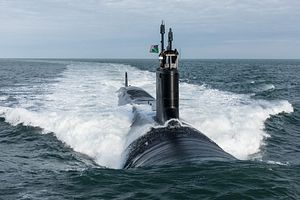Despite increased supplemental defense spending in the compromise bill that funds the U.S. government for the rest of 2017, for the 2018 budget, top lawmakers on the House Armed Services Committee are focusing less on how to fund a 350-ship fleet than on increasing maintenance funds for the current fleet. Maintenance shortfalls have had dramatic impacts on all parts of the U.S. fleet: ships, submarines, and aircraft. Persistent calls from the U.S. Pacific Command for more submarines, however, highlight a tension between building new submarines and keeping the current submarine force ready.
The ranking members of House Armed Services Committee recently told an event hosted by the independent U.S. Naval Institute and the Center for Strategic and International Studies that their budget priority for next year was to get more funding for the Navy not just to maintain and repair its ships and aircraft, but to invest in aging government-operated shipyards that are unable to keep up with the pace of work.
Representative Joe Courtney (D-CT), whose state is home to major submarine bases, explained how a lack of maintenance capacity and funding had already caused submarine deployments to be delayed or canceled. One submarine’s planned two-year maintenance period ended up taking four years to complete, another also spent four years tied to a pier awaiting work, and yet another lost its certification to dive, a submarine’s raison d’etre, because shipyards were unable to conduct maintenance in time.
Shortly after these maintenance issues were being highlighted to the committee, the head of the U.S. Pacific Command, Admiral Harry Harris, told them that he badly needs additional submarines. Harris testified that he only gets about half of the submarines that he requests from the Navy, while noting this was just to meet his “steady state” requirements during peacetime. He is concerned about the Navy’s ability to send additional submarines that might be required in a major contingency in a timely manner.
It was a worry that Admiral John Richardson, who as chief of naval operations is responsible for providing naval forces to combatant commanders like Harris, previously expressed in his own recent testimony. While the Navy was keeping up with peacetime deployment demands, maintenance backlogs meant there could be delays getting additional “surge” forces forward in the event of a conflict.
Richardson told the committee that failing to fully fund the U.S. Navy’s maintenance requirements had the same effect as cuts to force structure – ships that can’t sail, submarines that can’t dive, and planes that can’t fly are no better than not having those ships, submarines, and planes to begin with.
The prospect of additional U.S. submarines being unable to deploy or surge for lack of maintenance funds or capacity is contrasted with China’s expanding submarine fleet. The U.S. fleet currently has 52 attack submarines, but as the older Los Angeles-class is retired, that number is expected to drop to only 42 by the end of the 2020s. Meanwhile, according to a 2015 Office of Naval Intelligence estimate, China will have at least 70 submarines by 2020.
Partly in response to this changing balance of undersea power, the U.S. Navy’s latest Force Structure Analysis calls for building a fleet of 66 attack submarines. However, these additional hulls have yet to be purchased, and the shipyards that build submarines have already struggled to expand their production from one submarine per year to two. The workers who build and repair submarines are the most specialized in the shipbuilding industry and are the most difficult and time-consuming to train. Shipbuilding executives say it can take five to seven years before a welder is skilled enough for the most difficult parts of submarine work.
This magnifies the importance of the U.S. Navy being able to keep its current submarine fleet ready. While it is uncertain how soon, or even whether, the additional submarines the U.S. Navy wants will be funded, the already strained shipbuilding industry is unlikely to be able to build them fast enough to maintain the relative gap with China’s submarine numbers in the 2020s, let alone begin to close it. While there are proposals to extend the service lives of older warships to keep the fleets overall numbers higher, this isn’t generally an option for submarines as the tremendous stresses that deep submergence puts on their hulls places hard limits on their service lives. As a result, the U.S. Navy cannot afford to leave hulls tied to piers awaiting work.

































